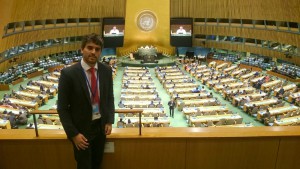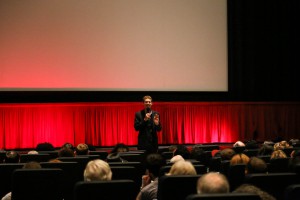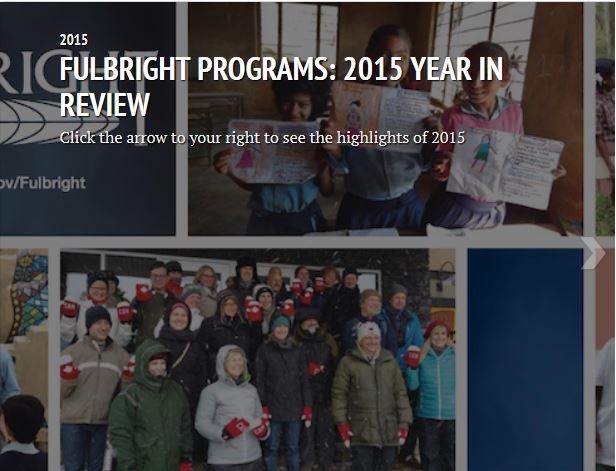Participating in an Open House at the Islamic Center of Manhattan, Kansas
January 4, 2016
Hamza Rehman, 2013-2014, Pakistan (left) engaging with a diverse, interfaith crowd at his local mosque’s open house in Manhattan, Kansas. The mosque event sought to dispel common myths and stereotypes about Muslims in the United States.
Pakistan is a country rich in cultures: Pathan, Punjabi, Baluchi and Sindhi, amongst others. As a Fulbright Student at Kansas State University, I aimed to convey some of Pakistan’s diversity and ethos in my fiction and non-fiction courses as a part of the Master of Arts in English Literature and Creative Writing program. To the United States at large—through conversation and interactions, I brought to life Pakistan’s historic Indus Valley Civilisation and its vales, mangrove forests, the Baltoro Glacier, the snowed-in Himalayas, the Karakoram and the Hindu Kush. To my Kansas State (“K-State”) peers in fiction workshop, I highlighted Pakistan’s diversity in my writing and engaged its many tongues and motley racial make-up: from blue-eyed, dark-blondes to tan-skinned, black haired characters.
Given Pakistan’s own ethnic and lingual heterogeneity, I was surprised when a K-State PhD candidate in Psychology solicited my help for a peculiar reason: because I was Pakistani, he wanted to use my voice in an “accents study” for his dissertation as an example of the “Arab accent.” Although I lauded his project and agreed to volunteer, his geography seemed off to me. After considerable explanation from my side, he reluctantly came to appreciate why I didn’t sound Arab: South Asia isn’t a part of the Middle East! He had said, “But it’s the same thing, right?” I responded, “No. Here’s a map. For an Arab accent, I’d begin with the Arab world, and even there, Arabic varies from country to country, and even city.” He narrowed his eyes incredulously, realizing “Muslim” didn’t always imply “Arab.” In that moment, the world became bigger for him, became less “U.S. and the rest.”
2015 Was a Great Year for the Fulbright Program
December 30, 2015Happy Holidays from the Fulbright Program!
December 28, 2015Take a look back at the Fulbright events, stories, videos, and images that made 2015 a memorable year by clicking on the e-card and reviewing our timeline. We look forward to all of the exciting Fulbright stories to come in 2016!
2015 Fulbright Holiday Card from Fulbright Program on Vimeo.
Becoming Part of the Sustainable Energy Revolution: My Experience at the UN
December 28, 2015
Franco Borrello, 2014-2016, Argentina, attending the 70th UN General Debate at the UN Headquarters in New York City on September 28th, 2015. During this historic event, the 2030 Agenda for Sustainable Development was adopted.
I have dedicated my career to studying energy, and it is one of the reasons why I came to Boston to pursue a Master of Science in Energy Systems at Northeastern University, thanks to the Fulbright Foreign Student Program.
This year, I have had the pleasure of participating in two high-level events at the United Nations Headquarters in New York City. In May, I attended the annual Sustainable Energy for All (SE4ALL) Forum. The SE4ALL initiative is a multi-stakeholder partnership launched by the UN in 2011 with three main objectives to be achieved by 2030: Ensuring universal access to modern energy services; doubling the global rate of improvement in energy efficiency; and doubling the share of renewable energy in the global energy mix.
During this event, I learned about success stories, innovations, and solutions deployed across the world in the energy sector. Most importantly, I interacted with colleagues and decision-makers in my field who shared valuable advice, which in turn, contributed to improving my own ideas. A very important takeaway I was left with was that establishing collaborative public-private partnerships has been very important to the energy field, especially in promoting and reducing risk in renewable energy projects designed for developing countries.

Egill Bjarnason, 2013-2015, Iceland, introducing his short documentary film, “Once the Ice Melts,” to a full house at the Del Mar Theatre in downtown Santa Cruz
In between a gloomy forecast on the future of capitalism and an Op-Ed about why everyone should walk barefoot, the Question of the Week in the student-run newspaper, City on a Hill Press, asked what kind of action people were taking to help the California water rationing. One undergrad no longer kept the tap running while brushing teeth. Another took shorter showers. The third took no showers at all. The fourth, pictured deadpan in a hoodie featuring the school mascot Sammy-the-Slug, was apparently “only drinking espressos because of the drought.”
UC Santa Cruz is the strange uncle in the University of California system, founded fifty years ago to embrace the “eccentric imagination.” Like all UC campuses, it is a research university. Yet the graduate population is less than 1,600, compared with some 10,500 and 12,200 graduate students at UC Berkeley and UCLA respectively. Here, redwood trees outnumber students.

